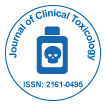
Journal of Clinical Toxicology
Open Access
ISSN: 2161-0495

ISSN: 2161-0495
Perspective - (2025)Volume 15, Issue 1
Occupational toxicology plays a critical role in identifying and understanding the harmful effects of hazardous substances encountered in the workplace. Among the most dangerous of these are heavy metals such as lead, mercury, arsenic, cadmium and chromium. These toxic elements are widely used or produced across industries, including mining, manufacturing and construction. Over time, they can accumulate in the human body, leading to serious chronic and acute health conditions. With evolving industrial processes and materials, managing and preventing occupational exposure to heavy metals remains a pressing concern.
Heavy Metal Toxicity in the Workplace
Heavy metals are characterized by high atomic weight and density and are toxic even at low concentrations. Occupational exposure varies by industry. Lead is common in battery production and older construction sites. Mercury exposure may occur in facilities manufacturing thermometers or fluorescent lights. Arsenic is often found in wood preservatives and electronic components, while cadmium is used in metal plating and batteries.
The toxicological impact of heavy metals depends on exposure dose, duration and route. For example, lead and cadmium can accumulate in bones and kidneys, leading to chronic toxicity. Mercury, especially in vapor form, is highly neurotoxic when inhaled. Even low levels of these metals can adversely affect vital organs including the nervous system, kidneys, liver and cardiovascular system.
Health Implications of Heavy Metal Exposure
The health effects of heavy metal exposure are often severe and irreversible. Lead poisoning is among the most well-documented conditions, associated with cognitive deficits, hypertension and renal damage. Even minimal exposure in adults has been linked to neurological issues, particularly in workers involved in smelting or construction.
Mercury exposure results in neurological and psychiatric symptoms, such as tremors, memory impairment and mood disturbances. Chronic exposure may also lead to renal and cardiovascular dysfunction.
Cadmium, commonly found in metalworking industries, affects the lungs and kidneys, with prolonged exposure increasing the risk of bone demineralization and fractures. Arsenic, frequently encountered in pesticide and electronics industries, has been associated with skin lesions, lung cancer and vascular diseases. In addition, long-term, low-level exposure to heavy metals has been linked to chronic diseases such as diabetes and cardiovascular disorders, further highlighting the need for continuous surveillance and intervention strategies.
Preventive Measures and Regulations
To manage occupational risks, several national and international agencies have established safety standards. OSHA and the World Health Organization (WHO) have defined permissible exposure limits for many heavy metals, guiding workplace practices. Engineering controls like proper ventilation and Personal Protective Equipment (PPE) such as respirators and gloves are essential for reducing exposure. For instance, airborne mercury or cadmium can be minimized through improved ventilation systems in industrial settings.
Routine biological monitoring measuring blood or urine levels of lead, mercury, or cadmium helps detect early signs of toxicity. Similarly, regular air quality assessments ensure workplace compliance with safety thresholds.
Education and training also play a crucial role. Workers must be informed about the risks of heavy metal exposure and trained in safe handling practices. Good industrial hygiene, including proper waste disposal and dust control, can significantly reduce occupational exposure.
The Future of Occupational Toxicology
The field of occupational toxicology is advancing rapidly. Biomonitoring technologies, including wearable sensors and non-invasive testing methods, are improving the early detection of harmful exposures. Additionally, genetic studies are uncovering why certain individuals are more susceptible to metal toxicity, paving the way for personalized occupational risk assessments.
Despite these advancements, challenges persist. Ensuring that safety protocols are universally implemented and updated in line with industrial innovation is crucial. As new technologies and materials are introduced into workplaces, continuous risk evaluation and adaptation of toxicological models are essential.
Occupational exposure to heavy metals remains a critical public health concern with potentially severe consequences for worker health. Through regulatory oversight, improved workplace practices, technological innovations and continued research, the burden of heavy metal toxicity can be reduced. As occupational toxicology evolves, it offers the tools and knowledge necessary to protect the health and safety of workers across industries worldwide.
Citation: Thompson A (2025). The Impact of Occupational Exposure to Heavy Metals on Worker Health. J Clin Toxicol. 15:588.
Received: 02-Jan-2025, Manuscript No. JCT-25-37435; Editor assigned: 06-Jan-2025, Pre QC No. JCT-25-37435 (PQ); Reviewed: 21-Jan-2025, QC No. JCT-25-37435; Revised: 28-Jan-2025, Manuscript No. JCT-25-37435 (R); Published: 07-Feb-2025 , DOI: 10.35841/0976-4860.25.15.588
Copyright: © 2025 Thompson A. This is an open-access article distributed under the terms of the Creative Commons Attribution License, which permits unrestricted use, distribution, and reproduction in any medium, provided the original author and source are credited.